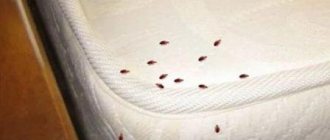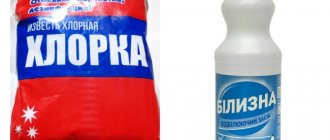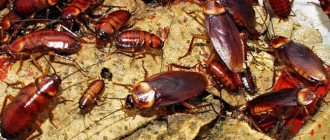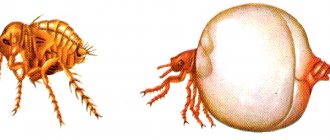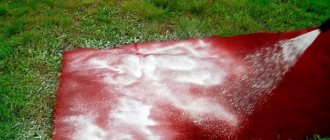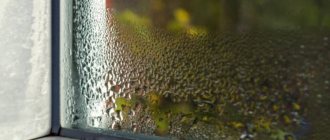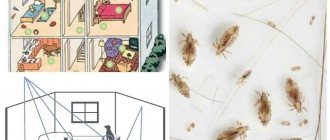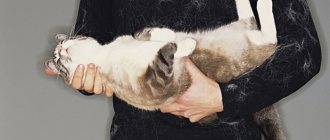How long do fleas live?
In favorable conditions for life, fleas live up to three months, during which the female lays approximately 500 eggs. The most comfortable conditions for parasites are a temperature of 21-26 degrees above zero, and a humidity of about 80%. When the temperature increases by 10 degrees, the development of fleas almost doubles. A decrease in temperature, on the contrary, leads to a slowdown in the growth of insects and an increase in life expectancy up to 2 years.
The reproduction cycle of insects also depends on the temperature regime. At optimal temperatures, the development period of the larvae is one month, at elevated temperatures - up to 10 days, at very low temperatures - up to 7 months. Then the eggs develop within 14 days; the insect remains at the pupal stage for about 20 days. In general, the full development cycle lasts from 10 days to one year, and life expectancy - from 1.5 months to several years.
Lifespan of fleas
How long fleas live without an animal in an apartment directly depends on how suitable the environment is for them.
The average lifespan of a flea is 2-3 months. During this period, the female is capable of laying up to 500 eggs, and they will bite their prey up to 100 times.
The figures given are relevant under ideal living conditions. Then the parasite dies a natural death. So to speak, from old age. Indicators of ideal conditions for different types of parasites differ.
Each species has an optimal combination of humidity and environmental temperature. The rat flea, for example, loves temperatures of 14-15 ° C and humidity up to 60%. The chicken flea tolerates temperatures up to 40 °C and humidity up to 80%.
Bloodsuckers can also live in an apartment for up to 2 months. It is very important for them to eat regularly. Therefore, many individuals prefer not to leave the host animal, despite all the discomfort they experience.
If the air temperature rises, the life of the bloodsucker is sharply reduced. For cat and dog parasites, the limit is 37 °C, at which the bloodsuckers will survive for 3-4 weeks. Their life cycle will accelerate.
But in the cold, flea life extends. Parasites can live even one and a half to two years.
How long does a flea live on a cat or dog ? Bloodsuckers have a hard time living as an animal. When a pet licks itself, itches, or rocks in the dust, bloodsuckers experience serious discomfort. Parasites often die during animal hygiene. 90% of fleas die when the animal is engaged in hygiene.
An adult cat can kill up to 12 parasites per day. In 3 weeks, she can remove up to 90% of all parasites from her fur.
It is curious that fleas are smaller when it is hot and larger when they develop in the cold. The eggs take approximately two weeks to develop. Then the insect begins the pupal stage. It lasts about 3 weeks.
The reproduction cycle from one generation of eggs to the next can vary from 10 days to a whole year. The life of a flea from the moment the egg appears until its death varies from a couple of months to a couple of years.
In nature they die quickly. The animals themselves regularly comb them out and bite them. They also die from parasites and infections.
How long do fleas live without food?
Fleas can go without food for about 2-3 months; their bodies are adapted to living in unfavorable conditions and the absence of a food source. But fleas cannot go on without food indefinitely, because they need fresh blood to reproduce and lay eggs.
When leaving the apartment with your pet for a long time, you should not expect that the fleas will die without the animal; they will definitely wait for the cat or dog to arrive and bite them. A peculiarity of country fleas and other types of fleas is their ability to sometimes feed on the blood of rats and mice, so they can wait for a long time for the owner with their pet.
Can they live in an apartment without animals?
To fully answer the question of whether fleas can live in an apartment without animals, it is necessary to consider the features of the insects’ life cycle. The optimal conditions for their full development are the following: constant temperature maintenance within 21 - 23 degrees, humidity - about 80%.
A particularly important factor for adult parasites and their larvae is the presence of a constant source of food. The absence leads to a slowdown in the development of the nymph and the absence of the ability to reproduce in the adult. In the absence of food, the life expectancy of the parasite increases.
Habitats of fleas in the apartment and in nature
In an apartment, dark and quiet places are suitable for insects to live:
- animal bedding;
- carpets;
- upholstery of sofas and armchairs;
- children's soft toys;
- old clothes;
- mattresses and bed linen;
- behind the baseboard and under the linoleum.
On the street, blood-sucking parasites choose places of residence with close proximity to animals that can provide them with a source of food (squirrels, rabbits, hamsters, rats, gophers, etc.). Places for living most often include garbage cans, sand heaps, basements, bird nests, and the burrows of some animals.
There are several types of domestic fleas that live in close proximity to humans:
- fleas of dogs and cats;
- mouse and rat;
- basement and ground;
- bed fleas;
- sandy.
Fleas are insects, although small, but they cause quite a lot of problems. Their bites are very painful and cause discomfort to the animal in the form of itching and irritation. In addition, these parasites are carriers of many unpleasant diseases. Therefore, it is important to get rid of them not only from pets in a timely manner, but also to remove them from all possible corners of the apartment.
Types of fleas
Today, science knows almost two thousand different species of fleas. Of this diversity, nearly five hundred species are the indigenous inhabitants of our country. Of these, which is at least a little encouraging, only thirty species can live in residential premises.
Let's look at typical representatives of these parasites by type in more detail:
domestic: houses and apartments are often inhabited by such types of fleas as human, rat, mouse, dog and cat. These pests are located directly on their host, and extremely rarely get off him, and then only for a short time. Even during reproduction, they “scatter” eggs between the fur or hair of the owner; ground or dust (basement): very small, about two millimeters, bugs, which are very difficult to see. They most often become infected in premises after visiting uninhabited houses or basements, along with dust. In the house, these parasites settle in the fabric surfaces of upholstered furniture, fleecy paths and carpets, behind baseboards. What should be said is that if you do not disinfect the infected room and how often in this case, it is unlikely that you will be able to completely get rid of these pests quickly. Only for some time, since, due to the inability to jump high, these insects constantly live on the floor and live for a long time without an animal, they themselves will begin to die, and it will be possible to clean the house;
herbal: this type of flea is not a bloodsucker. They are tiny in size and another significant difference from ordinary fleas is their dark green color. These parasites live in courtyards, from where they are carried into living quarters. They are dangerous only for indoor plants, while they are not at all harmful to humans; bed or household lice: very often confused with body lice or linen lice, but the latter are larger in size.
Methods for eliminating fleas in animals
Pets must be treated first. There are many means for these purposes.
Special shampoos . The product is applied to the pet’s fur while bathing, after 3-5 minutes it is washed off with clean water, then the animal must be thoroughly combed.
Sprays and drops are very effective in controlling fleas. The drops should be applied to the animal's skin along the ridge to prevent the drug from being licked off. The spray is applied to the entire coat by spraying.
Anti-flea collars are used not only to get rid of parasites, but also as a preventive measure. Biological or chemical flea collars for dogs and cats can be purchased at veterinary clinics or pharmacies.
What are fleas afraid of?
The greatest danger to insects comes from substances that act to destabilize the nervous system. Fleas, like many other insects, are afraid of smells. In other words, insecticidal agents force them to leave their owner, no longer jumping on him. Insecticidal agents develop paralysis, which leads to a stop in the movement of plasma in the body, resulting in death.
These parasites are also afraid of the cold; they cannot reproduce at -10 degrees. Often in winter, bird sheds freeze out. Water is a dangerous environment for insects. Therefore, frequent baths for animals reduces the number of animals in the household.
Insects do not perceive strong odors. Apartment renovations using paints, varnish, solvents, cement and putty cause insects to migrate.
There are plants in nature that also repel them:
- sagebrush,
- walnut oils, camphor, aloe,
- spruce, pine, juniper,
- eucalyptus,
- tansy,
- carnation,
- thyme,
- Ants attack flea larvae and are therefore considered their potential enemies.
Folk remedies against fleas in animals
- Treat your pet's fur with a solution containing essential oils of lavender and cedar (2 drops of oil per 500 ml of water). Spraying should be done daily for two weeks.
- Make a compress from a mixture of camphor alcohol, 3% acetic acid and regular cologne. Hold a plastic bag in the area of the cat's neck moistened with this solution. Then comb the coat well over a bowl of water.
- Dissolve regular table salt in warm water and keep the cat in it for about 10-15 minutes.
- Chop a couple of cloves of garlic and add half a glass of water, let it sit overnight, and rub the resulting solution into your pet’s skin.
- Combing the fur using baking soda; after the procedure, the animal must be washed.
- Treating the animal with lemon spray. Cut the lemon into several parts and boil in a liter of water. Leave the resulting liquid for 6-8 hours, strain and pour into a spray bottle.
After removing fleas from pets, it is necessary to carry out a general cleaning of all areas where parasites may live.
Where do fleas come from in the house?
It is generally accepted that fleas appear in apartments from domestic animals, which carry them on their fur. However, this statement is absolutely not true. Where do fleas come from in an apartment?
Their eggs and larvae can enter the house along with soil carried on shoes; adult insects can enter the living space from the attic, basement or entrance. If they are not noticed in time, they will quickly multiply and become a huge problem over time. For this reason, if at least one individual is detected, it is necessary to treat the entire apartment and pets for fleas in a short time.
To understand where fleas came from in the apartment and how to get rid of them, it is necessary to conduct a thorough inspection of all the nooks and crannies of the home. It should be remembered that these insects prefer polluted areas that are away from sunlight. Damp and dusty areas attract them most.
After inspecting and detecting flea larvae, their eggs or adults, it is necessary to treat the room as quickly as possible. Various insecticidal agents that can be purchased at a veterinary pharmacy or pet store have a very good effect. Entomozan shows excellent results - at a very affordable cost, it is completely safe for animals and humans, has almost no odor and perfectly eliminates fleas.
Proper treatment of a room for fleas includes washing floors and walls, destroying old clothes and unnecessary rags. In addition, it is necessary to rid all pets of fleas. Modern science offers a wide range of various products for cats, dogs and other pets. The drugs “Bravecto”, Frontline Nexgard”, “Stronghold” in combination with flea collars have a particularly good effect. Such products will help to reliably protect your pet from any blood-sucking insects for up to 6 months.
Room treatment
Today, the choice of products in stores to combat parasites is very large - you can find drugs in the form of aerosols, concentrated solutions, various powders and pencils.
Concentrates have the greatest effect and are low cost. One bottle of this product is enough to treat the entire apartment. However, the drugs are very toxic and have an unpleasant odor; the procedure must be carried out with gloves and glasses, in the absence of children and animals.
The most famous con, “Taran”, “Dobrokhim”, etc.
Aerosols in cylinders can be used to treat office and residential premises. They are not affordable for everyone, but they are very convenient and easy to use, and sometimes have a pleasant aroma.
The treatment should be carried out with the windows and doors closed; it is possible to ventilate the room 2 hours after the procedure.
The following brands are popular: “Raptor”, “Dichlorvos”, “Reid”, etc.
Powders and pencils : mainly used to remove flea larvae in places where they are most concentrated (basements, attics, cellars). They are low cost and have a good effect in getting rid of parasites.
You can purchase the following names: “Phenaxin”, “Tornado”, “Baygon”, etc.
If you are unable to cope with harmful insects on your own, you can use the services of a special service that will professionally help solve the problem quickly and reliably.
The preparations used by the services are highly toxic, so it is better to leave home for 2-3 days during treatment, and upon return, thoroughly wash the floors and wipe all surfaces with special products.
Means for killing fleas and their larvae
What to do if there are fleas at home? Immediately begin disinfection and eliminate the source of infection. Effective means for destroying parasites and their larvae:
- Such drugs as “Executioner”, “Tetrix” and “Kombat” have proven themselves well. In the form of a spray, the Raptor aerosol is effective.
- Microscopic capsules of insecticides “Dana” and “Get” are safe for pets, as they are odorless and have a low hazard class when used in enclosed spaces.
- At the beginning of the invasion, ordinary Dichlorvos can cope with the problem; now there are odorless sprays. But they are still toxic.
- The Butox solution has a good effect - one ampoule per five liters of water. The floors must be washed with the solution three times, at intervals of 24 hours. After a week, spray the floors with a more concentrated solution - one ampoule per liter of water. The drug can be purchased at a veterinary pharmacy.
- Proven folk remedies do not have exquisite aromas, but they act effectively and reliably - kerosene, vinegar and turpentine kill parasites instantly.
To prevent insects from appearing in the apartment, especially if you keep pets, it is important to carry out preventive disinfection. Tansy or wormwood, laid out on the threshold and in the corners, will repel fleas, but will not be able to effectively fight these insects. Tips to help fight fleas in your apartment:
Tips to help fight fleas in your apartment:
What types of fleas can live in the house
Fleas feed exclusively on the blood of humans and warm-blooded animals. This naturally leads to the question: how long can a flea live without food if there is no food source nearby?
Like the vast majority of parasites, fleas, under unfavorable conditions, fall into suspended animation, in which they can remain for a very long time. In the absence of a regular supply of food to the insect’s body, they lose the ability to reproduce, but do not die themselves. In the same way, flea pupae and larvae go into suspended animation. Therefore, you should not expect favors from nature; it is better to try to get rid of uninvited guests as soon as possible.
The life cycle of a flea is maximally tuned to survival. Some individuals can even survive the animals on which they settled. They are able to withstand environmental challenges, both heat and cold.
If the host animal dies, the fleas immediately leave it. The blood of a dead animal does not suit them.
The larva, depending on conditions, lives 5-45 days. Humidity and ambient temperature are very important for it.
It is very important that she has access to food - the excrement of adults, imago
If you have a flea infestation, there will be a lot of eggs and droppings on the carpets, pet bedding, upholstered furniture, and other areas.
In apartment conditions, the larva develops into a pupa in 7-12 days. If the room is cool, dry, and there is little nutrition, the development process is slowed down for up to a month and a half.
Then the pupal stage begins. It develops in a cocoon for 7-19 days. Females develop 20% faster. If the temperature drops, the development of the pupa slows down.
The development process is affected by humidity, temperature, and nutrition. The better the larva ate, the longer the pupa develops. In order for her to leave the cocoon, the level of nutrients and fluid in her body must become critical. In some cases, being in a cocoon can take up to 5 months.
The flea leaves the cocoon when it senses the presence of its owner. She learns about it by temperature and pressure. These signals become a call to exit.
